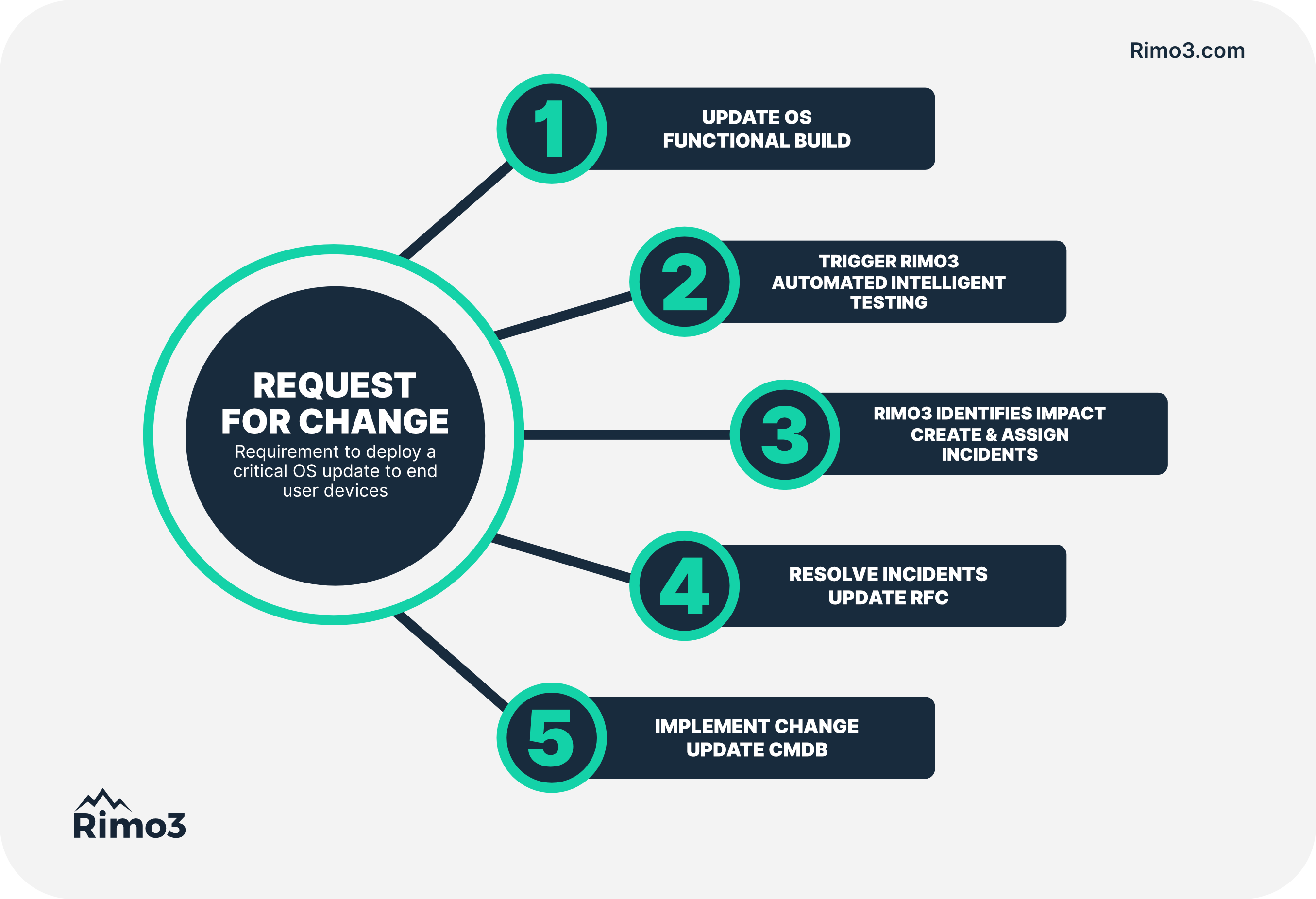Intelligent Application Automation: Why It’s Crucial for Change Enablement

As we face the constant challenge of adapting to change, businesses struggle to keep their application deployments on pace.
Application migration and automation emerges as the crucial linchpin, transforming the agility of IT Service Management and propelling change enablement to new heights.
Applications are the lifeblood of end user computing and introducing change can pose risks and negatively impact businesses.
Below will walk through a use case on Rimo3 and how we can provide the automation required to embrace ITLv4 Change Enablement.
Understanding ITIL Change Management
Information Technology Infrastructure Library (ITIL) change management is a core discipline in IT Service Management (ITSM). It’s most often used in the context of implementing changes within an IT environment. The IT environment is there to support the business and its employees & customers.
Changes like updating end user device operating systems (patches or upgrades) and maintaining the application estate that resides on the user’s endpoint devices.
These changes need to be planned, categorized (Standard, Normal, Emergency) approved, implemented, and then reviewed post implementation.
These best practices ensure change is made in a structured process where it can be tracked to continuously be approved upon. Because of the increasingly growing complexity of IT landscapes over time, processes intended to make IT professional’s life easier became more cumbersome.
The Key Disadvantages of Change Management ITILv3
All good frameworks need to evolve over time to keep up with the current requirements and demands. The frequency of change is increasing exponentially in today’s IT landscape and with that brought forth disadvantages to the change management v3 principles.
Here are some of those disadvantages:
- Resource Intensive: big changes can affect many users and systems. Each stakeholder must be included in the change process and do their part to ensure success.
- Time Consuming: Manual efforts tend to take time
- Overall Resistance to Change: Human nature is to resist change, especially when change disrupts comfort
Is there a better way? There is.
The evolution of streamlining Change Management is Change Enablement and here’s why.
What is Change Enablement and Why Should You Make the Shift?
Change enablement is the elevated approach to change management leveraging version 4 of Information Technology Infrastructure Library (ITILv4) best practices. It’s designed to equip people with processes, tools, and strategies to manage the increased pace and complexity of change in today’s world.
When done effectively it ultimately results in more changes being implemented faster and originating from all lines of business. The key component to embracing change enablement is to leverage automation to enhance existing processes.
A Practical Use Case for Change Enablement
Let’s walk through the steps involved in a critical OS update before deploying to thousands of end user devices hosting thousands of applications.
Here are the steps:
- Step 1: Request for Change (RFC) is created leveraging an ITSM platform to deploy the critical OS update.
- Step 2: The functional OS build is updated. (This can be orchestrated from the ITSM platform)
- Step 3: The RFC then triggers an integration via API to Rimo3 to initiate an automated Intelligent test of the applications that are deployed on the updated build.
- Step 4: The RFC is record is updated with the data results from Rimo3 and impact is identified.
- Step 5: ITSM platform auto generates Incidents records and links them to the RFC for negatively impacted applications and are routed to appropriate resources for resolution.
- Step 6: Once Incidents are resolved, the RFC is updated and approved.
- Step 7: Change is Implemented
- Step 8: Assets associated with the updates are updated in the ITSM CMDB
- Step 9: Upon successful Implementation of the RFC, post change review is performed

There are four positive outcomes resulting from this change enablement story powered by Rimo3.
Change Implementation is accelerated, automated, and devices are updated ensuring compliance and security.
Decrease of user productivity risk is mitigated by leveraging Rimo3 to ensure applications will not be negatively impacted as a result of the Change.
Operational efficiency is gained by embracing a DevOps approach in a traditional Windows environment removing as much manual human efforts as possible.
Resources are unburdened with manual time-consuming task and liberated to focus on more strategic initiatives.
Simplify the Manual and Complex with Smart Automation
Rimo3's software platform harnesses intelligent automation to streamline application management within IT Service Management, providing essential data and insights to optimize application portfolios.
By facilitating change enablement, it helps customers mitigate risks and reduce the impact of changes, enabling swifter work processes and expedited deployment. This ensures end-users maintain access to their workspaces and applications, which are vital for sustained business success, simplifying the manual and complex aspects of application management.
Leveraging Rimo3’s RESTful API integration fabric, a key ITSM discipline like change enablement can be powered by Rimo3.

